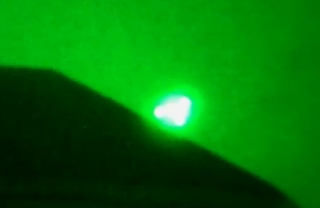'Invisible UFOs' Fill the Skies

"Why are all the good UFOs invisible?" one Gather.com user asked in response to the latest "invisible UFO" report posted to the site.
You might have thought a defining characteristic of a UFO would be visibility. But thanks to zealous alien hunters doggedly scanning the sky with night-vision cameras, a new class of flying objects that only emit infrared light has emerged from the darkness. Are they spies from the great beyond?
"Some people claim to see actual battles between UFOs up in the sky, using night-vision equipment," the ufologist Robert Sheaffer told Life's Little Mysteries. "Those devices magnify faint objects so much that the sky seems to be filled with invisible UFOs. In reality, of course, they are seeing owls, bats, moths, airplanes, satellites, etc." Night-vision optics trade low resolution for high sensitivity, he explained, so that points of light (such as distant satellites) spill out into circles that make the objects appear huge.
However, some of the invisible UFOs out there really are spies of a sort — or whatever else you choose to call military drones. [7 Things Most Often Mistaken for UFOs]
Consider, for example, an invisible triangle UFO recently caught on camera by the Laredo Paranormal Research Society, a Texas group. In their footage, captured using an infrared-sensitive third-generation night-vision camera and posted to YouTube July 13, an object composed of three evenly spaced glowing orbs streaked southward across the field of view and disappeared behind the roof of a house.
According to LPRS founder Ismael Cuellar, the "infrared-cloaked" object could not be seen with the naked eye, and cruised silently. "[We] have ruled out birds, bugs, airplanes, helicopters, and even flying drones by comparing them side by side as a point of reference," Cuellar told Life's Little Mysteries. This seems to leave just one explanation: It's a cloaked alien spaceship.
Not so, according to Ben McGee, a geoscientist, aerospace consultant, UFO skeptic and lead field researcher on the National Geographic series "Chasing UFOs." In McGee's opinion, all the signs point to this object being a border patrol drone with infrared anti-collision or identification lights. Here's why he thinks so.
Sign up for the Live Science daily newsletter now
Get the world’s most fascinating discoveries delivered straight to your inbox.
"Nearly one-third of traffic through the nearby Laredo International Airport has historically been military in nature. Laredo is very near to the Mexican border. The military is increasingly using drones to assist with border security, which are small, quiet, and dim (to the naked eye) aircraft," McGee wrote in an email, adding that most drones are also triangular. [UFO Sightings Are 3,615 Times More Common than Voter Fraud]
This alleged drone oversaturated the camera's infrared sensor. Why? "Particularly with unmanned aerial vehicles (UAV), anticollision systems are of the utmost importance," he wrote. "One custom UAV lighting manufacturer recently announced custom infrared navigation lights for a major UAV defense contractor. Using these lights in 'constant-on' infrared mode would make the tail, belly, and wingtips extraordinarily bright in infrared, washing out the shape of the aircraft in-between."
And that description pretty closely matches the case.
"In short," McGee said, "high-intensity/close-range infrared lights interacting with a sensitive infrared camera is the problem — turning an aircraft into a triangular blob — rather than the infrared camera being the solution to revealing invisible triangles or pyramids zooming about our airspace."
Follow Natalie Wolchover on Twitter @nattyover or Life's Little Mysteries @llmysteries. We're also on Facebook & Google+.
Natalie Wolchover was a staff writer for Live Science from 2010 to 2012 and is currently a senior physics writer and editor for Quanta Magazine. She holds a bachelor's degree in physics from Tufts University and has studied physics at the University of California, Berkeley. Along with the staff of Quanta, Wolchover won the 2022 Pulitzer Prize for explanatory writing for her work on the building of the James Webb Space Telescope. Her work has also appeared in the The Best American Science and Nature Writing and The Best Writing on Mathematics, Nature, The New Yorker and Popular Science. She was the 2016 winner of the Evert Clark/Seth Payne Award, an annual prize for young science journalists, as well as the winner of the 2017 Science Communication Award for the American Institute of Physics.
Most Popular



